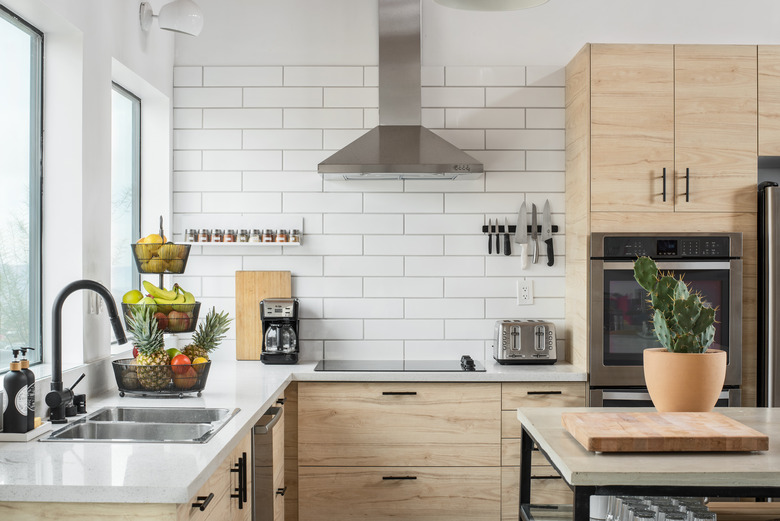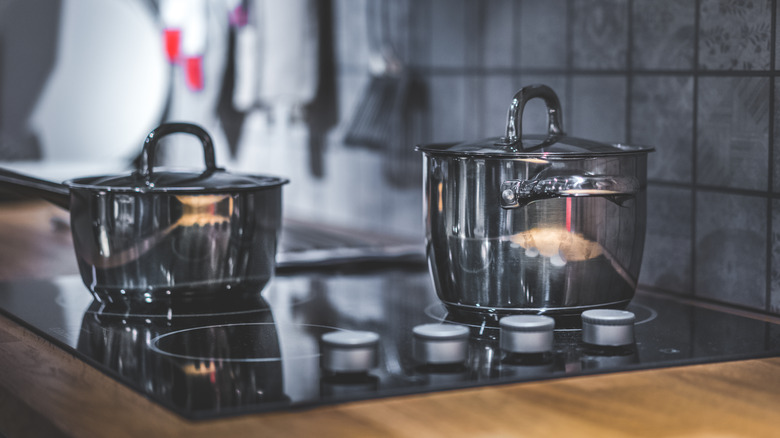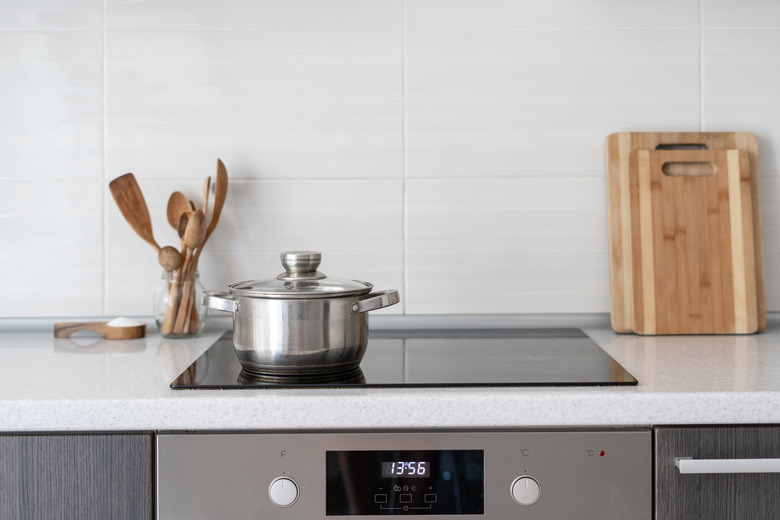Do Electric Stoves Need A Special Outlet?
We may receive a commission on purchases made from links.
An electric stove, like a water heater or a central air conditioner, is a high-demand appliance and operates at 240 volts instead of the 120 volts typically supplied to small appliances and lights. You might see the voltage rating listed on some stove labels as 220, 230 or even 250 volts, but these all mean the same thing, which is that the stove uses the full voltage supplied at the electrical panel, nominally 240 volts.
In general, the panel splits the input cable into two 120-volt legs with a neutral, or "return," wire between them, and while most household receptacles and lights connect to one or another of these legs, an electric stove connects to both of them. This means that a free-standing electric stove does need a special 240-volt outlet. In the case of an electric cooktop or built-in oven, it requires hardwiring to the electric system of the home — building codes do not permit using a 240-volt outlet in this scenario.
Tip
An electric stove plugs into a special 240-volt, 30- or 50-amp receptacle.
An Electric Stove Is a 240-Volt Appliance
An Electric Stove Is a 240-Volt Appliance
The outlet for an electric stove has to be rated for the current draw—or electrical consumption—of the stove. It must be connected to a double-pole circuit breaker that contacts both hot legs in the service panel and wired with heavier cable, usually a six-gauge cable. The cable for a 240-volt circuit is bundled with two hot wires, a neutral and a ground as opposed to 120-volt cables, which have only a single hot wire.
The neutral wire in a range circuit allows the appliance to draw both 240 volts (for the heating elements) and 120 volts (for the timers, alarms, lights, etc.). This is why range circuits are often called 120/240-volt circuits.
The Standard 4-Prong Stove Receptacle
The Standard 4-Prong Stove Receptacle
The standard electrical outlet for a 50-amp electric stove is the NEMA 14-50, which has four input slots. Two vertical ones for the hot wires are situated opposite each other, while a third vertical slot for the neutral wire is positioned between them opposite a semicircular slot for the ground wire. Each slot connects to a terminal screw on the back of the outlet, and that's where you connect the wires.
This is the outlet you would also use for a stove that draws 40 amps, but if you have a light-use cooktop that draws only 30 amps, you need a NEMA 14-30 receptacle. It looks almost the same, but instead of a straight slot for the neutral pin, it has two slots that form a 90-degree angle. The design difference prevents you from using the receptacle to power an appliance that exceeds its current rating.
My Existing Stove Outlet Has Only 3 Slots
My Existing Stove Outlet Has Only 3 Slots
If you're replacing an old stove with a brand-new one, you may be puzzled to find that the outlet into which the old one was plugged has only three slots arranged in a circle. That's because the stove was manufactured and the outlet purchased before the National Electric Code (NEC) began to require grounding on all 240-volt circuits. Before it made this requirement, the NEC permitted the neutral wire to act as the ground, but even though that has now changed, it doesn't mean you have to rewire the outlet to plug in the new stove because existing three-slot outlets are grandfathered in.
The only way to connect a new stove to an existing three-slot outlet, is to replace the power cord, and for safety reasons, this job should be done by an electrician. The electrical panel on a new stove has two hot terminals, a neutral and a ground, and all are independent. If you want to connect a three-prong cord, you need to bond the neutral and ground terminals with a bonding plate or piece of six-gauge wire before connecting the neutral cord wire to the neutral terminal.
In the obverse situation, when you want to plug an old stove into a four-slot outlet, you'll have to install a four-prong cord, but the panel in an old stove only has three terminals. Because the ground terminal is missing, you need to connect the ground wire to a ground screw in the stove body. The screw has often already been installed by the manufacturer, but if not, get an electrician to install one. This configuration will protect the user from electric shock, but the circuitry will still be grounded by the neutral wire.
The Basics of Wiring an Electric Stove
The Basics of Wiring an Electric Stove
If you're installing a new electric stove as part of a home improvement project, installing the receptacle may be part of the job, although 240-volt wiring is generally not a DIY project and should be completed or at least overseen by a licensed electrician. The electrical code dictates that the stove be on a dedicated circuit to prevent overloading the circuit breaker, which is true for all 240-volt appliances. Before you begin the installation, you should check the panel to make sure you have room for a 240-volt breaker, which requires not just one slot but two adjacent ones. (You'll know you have room if you see two adjacent spaces in the panel not already occupied by breakers.)
At the panel end of the circuit, the electrician separates and strips the wires inside the cable and connects the neutral (white) wire to the panel's neutral bus and the ground (green or bare) wire to the ground bus. Each of the hot wires (black and red) connects to one of the brass lugs on the breaker. The electrician then snaps the breaker into the two available slots on the panel.
Before installing the breaker, the electrician has to route the wire through the house structure to the wall behind the stove where the receptacle is attached, either to the wall studs or the floor. The two hot wires (red and black) are attached to the two brass terminal screws in the back of the receptacle, the white neutral wire is connected to the silver terminal screw and the ground wire is connected to the green (ground) terminal. Because of the thickness of the wire, electricians install ring connectors onto the circuit wires and use the connectors to attach the wires to the terminals. After the receptacle is fully installed, the electrician flips on the breaker to energize the circuit.
Does a Range Need GFCI Protection?
Does a Range Need GFCI Protection?
The NEC has been steadily expanding requirements for ground-fault circuit-interrupter (GFCI) protection, and the 2020 edition now stipulates that 240-volt outlets must also have it if they are in locations in which GFCI protection would be required for 120-volt outlets. This means that a stove outlet located within 6 feet of the kitchen sink must have GFCI protection.
This rule applies to new construction only, so you don't have to relocate your existing outlet or replace it with a GFCI outlet if it's too close to the sink. It's a new rule, so finding a 240-volt GFCI outlet may be challenging if you want to make the change or you want to install a new circuit. It's usually a better idea to install a GFCI breaker in the panel, which performs the same function, satisfies code and is easier to find and install.


